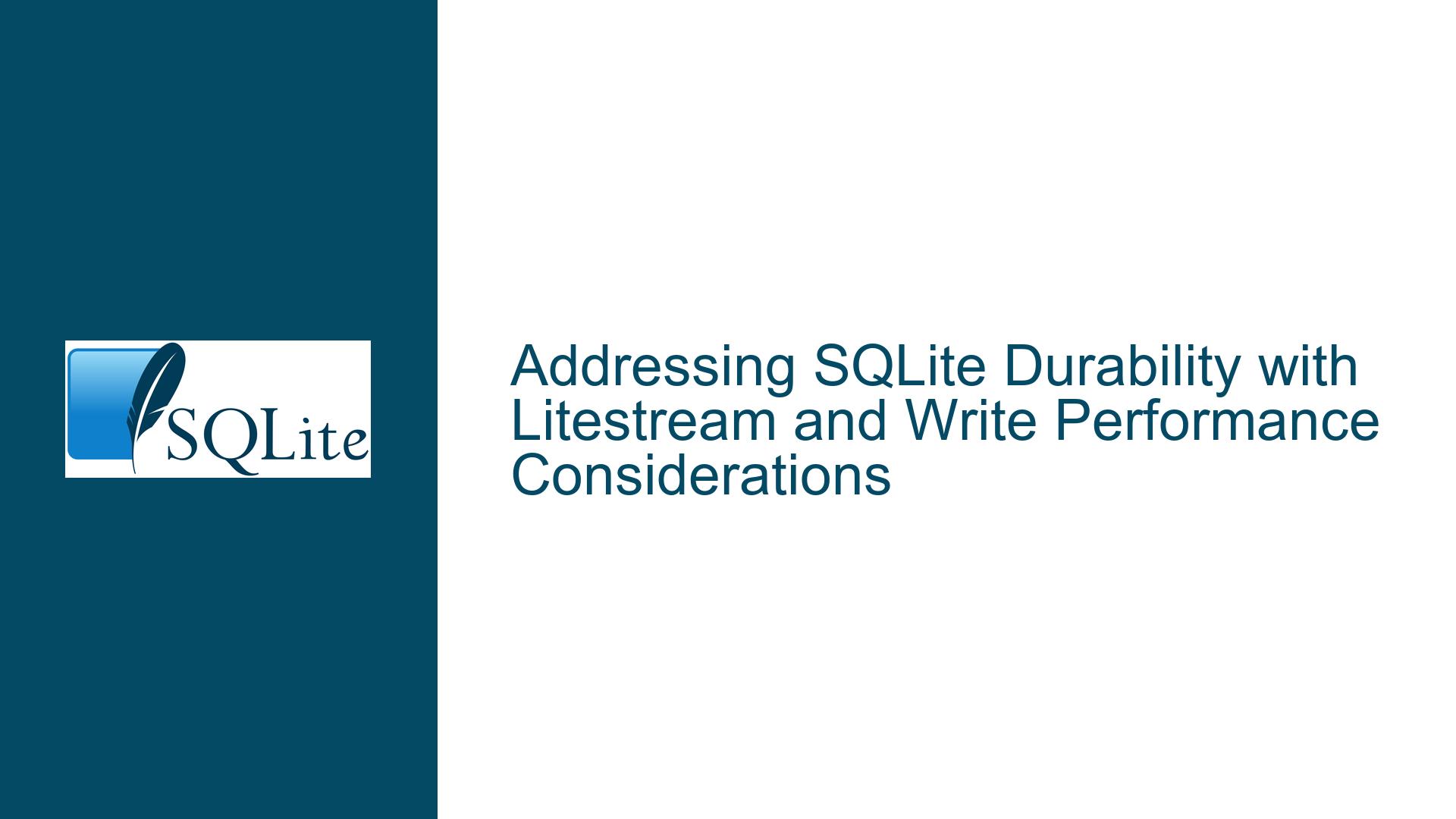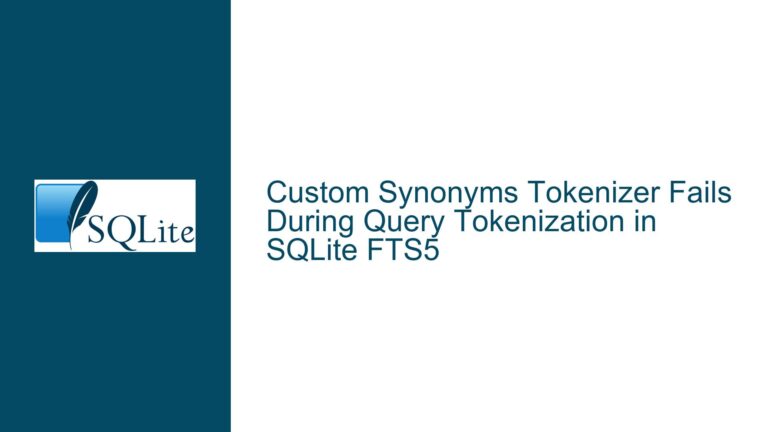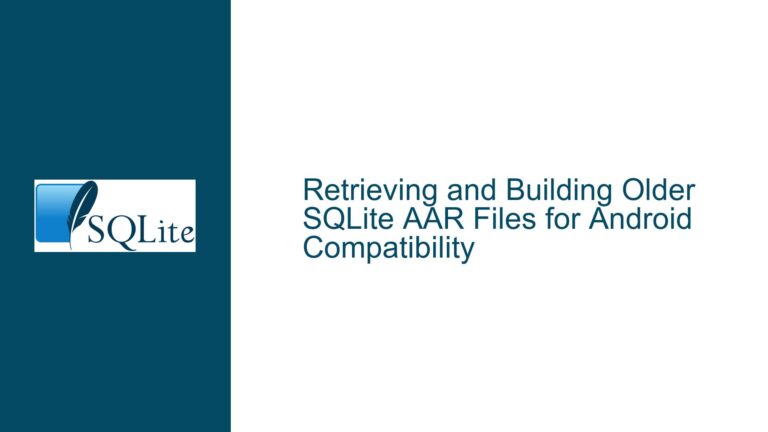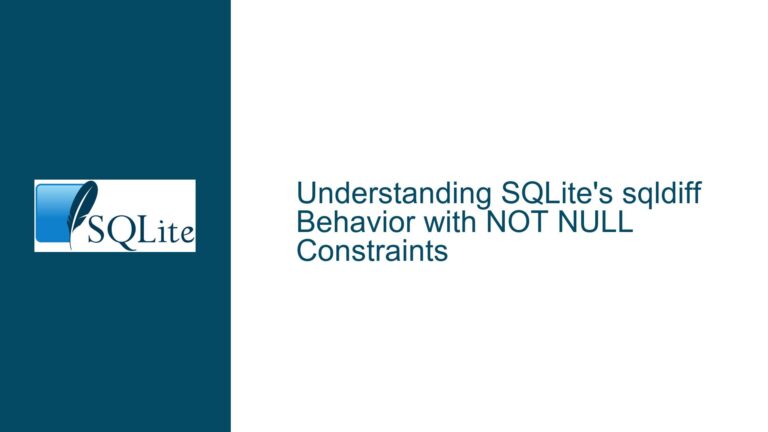Addressing SQLite Durability with Litestream and Write Performance Considerations
Understanding SQLite’s Durability Landscape and Litestream’s Role
SQLite is a widely adopted embedded database due to its simplicity, portability, and zero-configuration design. However, its default durability guarantees are often misunderstood. By default, SQLite employs a synchronous mode that ensures transactions are flushed to disk before acknowledging a write operation. This behavior is controlled by the PRAGMA synchronous setting, which defaults to FULL in modern SQLite versions. While this provides strong durability, it introduces performance overhead due to frequent disk I/O operations. Applications requiring high write throughput often face tradeoffs between durability and performance.
Litestream emerges as a solution to this problem by decoupling durability from the core database engine. It operates as a continuous replication tool that streams SQLite’s write-ahead log (WAL) changes to external storage systems like Amazon S3, Azure Blob Storage, or local directories. This approach allows applications to maintain SQLite’s lightweight nature while achieving near-real-time backups and point-in-time recovery. Litestream works by tailing the WAL file, capturing changes as they occur, and asynchronously replicating them to configured targets. This design avoids invasive changes to the application layer, as Litestream runs alongside the primary database process.
The durability improvements Litestream provides are significant but not absolute. For instance, if a hardware failure occurs before Litestream replicates a WAL frame, that data may be lost. However, this risk is mitigated by adjusting replication intervals and leveraging cloud storage’s inherent redundancy. Litestream’s architecture is particularly effective for edge computing, IoT devices, or single-instance web applications where traditional database replication setups are impractical. Critically, Litestream does not replace SQLite’s transactional guarantees but complements them by adding an additional layer of data protection outside the local filesystem.
The interaction between SQLite’s WAL mode and Litestream is foundational to its operation. SQLite’s WAL mode allows concurrent reads and writes by separating writes into a separate log file, which Litestream monitors. When a transaction commits, SQLite appends changes to the WAL file and updates the shared-memory file (-shm). Litestream reads these appended frames, batches them, and uploads them to remote storage. This process introduces minimal overhead because Litestream operates outside the critical path of transaction commits. However, the efficiency of this pipeline depends on factors such as network latency, storage system throughput, and the frequency of WAL checkpoints.
Factors Influencing Write Performance in SQLite with Replication
Write performance in SQLite when using Litestream or similar replication tools is governed by multiple interdependent variables. The first is SQLite’s internal journaling mode. While WAL mode improves concurrency, it also introduces checkpointing, where the WAL file is periodically merged into the main database file. Frequent checkpoints can stall write operations, especially if the database is large or storage media is slow. Litestream does not directly interfere with checkpointing but may indirectly affect it if replication lags cause WAL files to accumulate, increasing merge times.
Another critical factor is the durability configuration of SQLite itself. The PRAGMA synchronous setting directly impacts how aggressively SQLite flushes data to disk. Setting synchronous = OFF disables flushing entirely, maximizing write speed at the expense of durability. In contrast, synchronous = FULL ensures that all writes are physically written to disk before a transaction is considered committed. Litestream’s replication operates independently of this setting, meaning that even with synchronous = OFF, replicated data in the WAL may still be asynchronously flushed to remote storage. However, this creates a window where data acknowledged to the application exists only in volatile memory or an unreplicated WAL file.
Network latency and bandwidth play a pivotal role in Litestream’s replication efficiency. If the replication target is a cloud storage service, high latency can delay the propagation of WAL changes, leading to replication lag. This lag does not affect the primary database’s write performance but increases the recovery point objective (RPO), which measures how much data could be lost in a failure. Applications requiring low RPOs must balance this with the network resources available. For example, edge devices with unstable internet connections may prioritize local write performance over immediate replication, opting to batch WAL uploads during periods of connectivity.
Filesystem performance is another often-overlooked variable. SQLite’s performance is heavily dependent on the underlying filesystem’s ability to handle small, random writes efficiently. On rotational hard drives, frequent fsync operations (triggered by synchronous = FULL) can become a bottleneck. Solid-state drives (SSDs) mitigate this but introduce wear-leveling concerns for write-heavy workloads. Litestream’s replication process adds read operations on the WAL file, which competes with SQLite’s own I/O. On systems with limited I/O capacity, this contention can degrade write throughput.
Transaction sizing and concurrency further complicate performance dynamics. Large transactions that modify many rows generate larger WAL entries, which Litestream must replicate in one batch. Smaller, frequent transactions reduce replication batch sizes but increase the overhead of transaction commit handling. Concurrent writers in WAL mode must contend with lock contention in the shared-memory file, which can serialize write operations. Litestream’s non-blocking replication does not exacerbate this, but the cumulative effect of high write concurrency and replication can strain system resources.
Optimizing SQLite for High Durability and Balanced Write Performance
To achieve optimal write performance with Litestream, start by auditing SQLite’s configuration. Set PRAGMA journal_mode = WAL if not already enabled, as this allows concurrent reads and writes while providing a stable foundation for Litestream’s replication. Adjust PRAGMA synchronous based on durability requirements. For environments where Litestream replication is frequent and reliable, synchronous = NORMAL can be a compromise—it flushes the WAL to disk approximately once per transaction, reducing fsync calls while still providing reasonable durability.
Tune the WAL checkpointing behavior to prevent uncontrolled WAL growth. The PRAGMA wal_autocheckpoint parameter determines how often SQLite automatically checkpoints the WAL. Setting this to a higher value (e.g., 1000 pages) reduces checkpoint frequency, minimizing I/O spikes. However, larger WAL files increase recovery time after a crash and require more storage. Monitor the WAL size using PRAGMA wal_checkpoint(TRUNCATE) and consider manual checkpointing during off-peak hours.
Litestream’s replication interval is controlled via its configuration YAML file. The interval parameter specifies how often Litestream syncs WAL changes to the replication target. A shorter interval (e.g., 1s) reduces data loss exposure but increases network usage. For applications with bursty write patterns, pairing a longer interval (e.g., 10s) with aggressive SQLite checkpointing can balance performance and durability. Use Litestream’s metrics endpoint or logs to monitor replication lag and adjust the interval dynamically if necessary.
Storage hierarchy optimization is essential. Place the SQLite database and WAL file on a filesystem with low latency and high throughput. If using cloud storage for replication, select a region geographically close to the primary database to minimize latency. For local replication targets, ensure the destination directory is on a separate physical device to avoid single points of failure. If using SSDs, enable the PRAGMA mmap_size to leverage memory-mapped I/O, reducing disk read overhead for large databases.
Application-level batching of write operations can dramatically reduce transaction overhead. Instead of committing each write individually, batch multiple changes into a single transaction. This reduces the number of WAL flushes and allows Litestream to replicate larger contiguous blocks of data. For example, instead of executing 100 INSERT statements in autocommit mode, wrap them in a BEGIN…COMMIT block. This technique is particularly effective for bulk data ingestion or batch processing workloads.
Monitor system resources comprehensively. Use tools like iostat to track disk I/O utilization, netstat to monitor network throughput to replication targets, and SQLite’s own sqlite3_status API to track memory and page cache usage. High disk wait times or network saturation indicate resource contention that requires mitigation—either by scaling up hardware, optimizing queries, or adjusting replication parameters.
In scenarios where write performance remains inadequate despite optimization, consider sharding the database or offloading read traffic to replicas. SQLite’s single-writer limitation means that write-heavy applications may benefit from partitioning data into multiple database files, each handling a subset of the workload. Litestream can replicate each shard independently, though this increases operational complexity. Alternatively, use a connection pooler with write-through caching to reduce lock contention.
Finally, evaluate whether SQLite is the appropriate choice for the workload. While SQLite excels in embedded and low-concurrency scenarios, applications requiring horizontal write scaling or sub-millisecond replication latency may need to explore distributed databases like PostgreSQL with logical replication, or cloud-native solutions like Amazon Aurora. Litestream bridges many gaps in SQLite’s durability story, but it does not transform SQLite into a clustered database. Understanding the tradeoffs between simplicity, performance, and scalability is crucial when designing systems around SQLite and Litestream.
This guide provides a comprehensive framework for diagnosing and resolving durability and write performance challenges in SQLite deployments augmented by Litestream. By systematically addressing configuration, replication parameters, and infrastructure constraints, developers can achieve a robust balance between data protection and operational efficiency.






